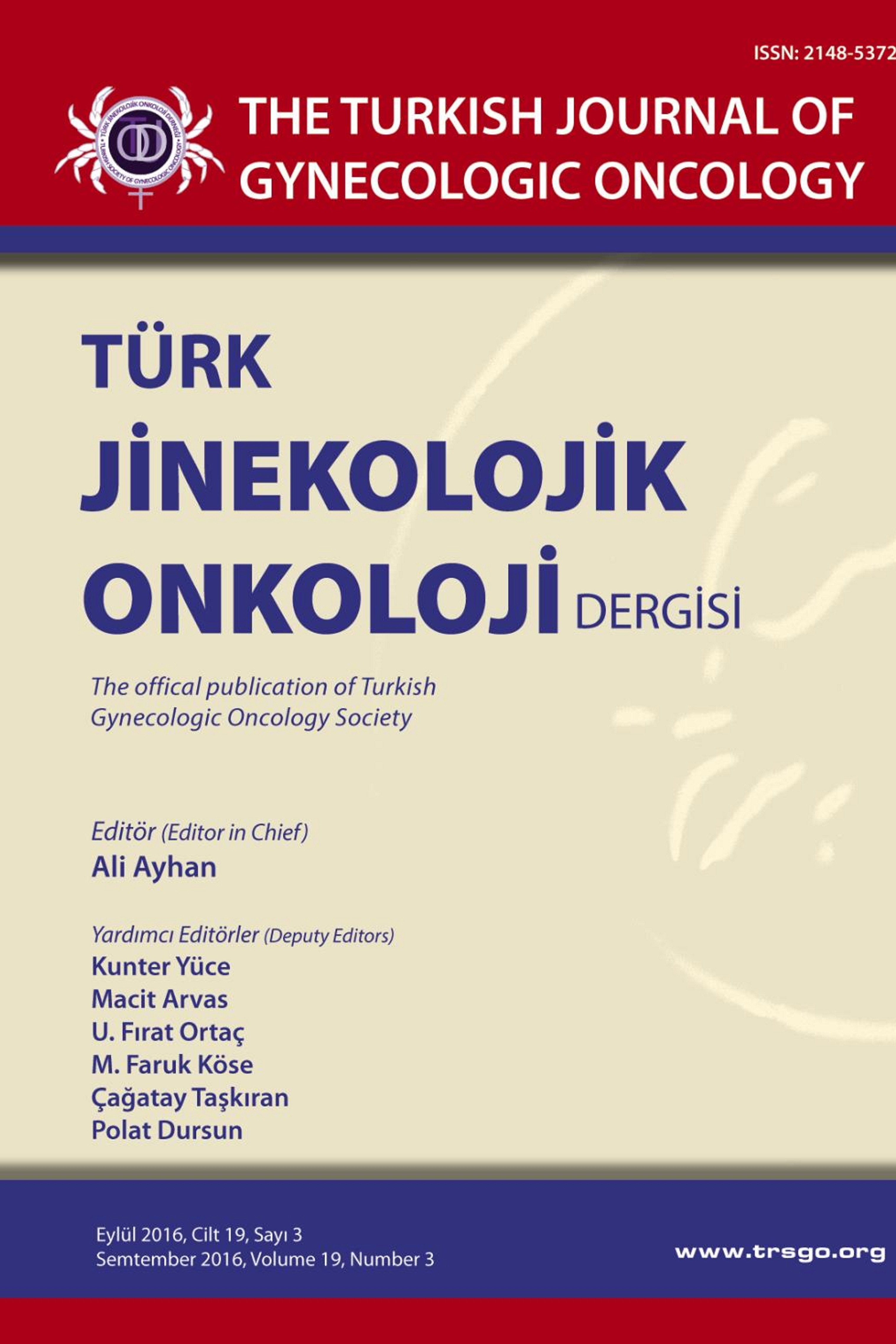OVER TÜMÖRLERİNDE SERUM VEGF DÜZEYİNİN DİAGNOSTİK VE PROGNOSTİK DEĞERi
Vasküler Endotelyal Büyüme Faktörü, Fibrinojen, D-dimer, Epitelyal Over Kanseri.
___
- 1. Candido Dos Reis FJ, Moreira de Andrade J, Bighetti S. CA 125 and vascular endothelial growth factor in the differential diagnosis of epithelial ovarian tumors. Gynecol Obstet Invest. 2002;54(3):132-6.
- 2. Li L, Wang L, Zhang W, Tang B, Zhang J, Song H et al. Correlation of serum VEGF levels with clinical stage, therapy efficacy, tumor metastasis and patient survival in ovarian cancer. Anticancer Res. 2004;24(3b):1973-9.
- 3. Ma Y, Qian Y, Lv W. The correlation between plasma fibrinogen levels and the clinical features of patients with ovarian carcinoma. J Int Med Res. 2007;35(5):678- 84.
- 4. Gadducci A, Cosio S, Tana R, Genazzani AR. Serum and tissue biomarkers as predictive and prognostic variables in epithelial ovarian cancer. Crit Rev Oncol Hematol. 2009;69(1):12-27.
- 5. Koh SC, Khalil R, Lim FK, Ilancheran A, Choolani M. The association between fibrinogen, von Willebrand Factor, antithrombin III, and D-dimer levels and survival outcome by 36 months from ovarian cancer. Clin Appl Thromb Hemost. 2006;12(1):3-8.
- 6. Oehler MK, Caffier H. Diagnostic value of serum VEGF in women with ovarian tumors. Anticancer Res. 1999;19(4A):2519-22.
- 7. Gadducci A, Ferdeghini M, Fanucchi A, Annicchiarico C, Ciampi B, Prontera C et al. Serum preoperative vascular endothelial growth factor (VEGF) in epithelial ovarian cancer: relationship with prognostic variables and clinical outcome. Anticancer Res. 1999;19(2B):1401-5.
- 8. Fasciani A, D’Ambrogio G, Bocci G, Luisi S, Artini PG, Genazzani AR. Vascular endothelial growth factor and interleukin-8 in ovarian cystic pathology. Fertil Steril. 2001;75(6):1218-21.
- 9. Demirkiran F, Kumbak B, Bese T, Arvas M, Benian A, Aydin S et al. Vascular endothelial growth factor in adnexal masses. Int J Gynaecol Obstet. 2003;83(1):53-8.
- 10. Cooper BC, Ritchie JM, Broghammer CL, Coffin J, Sorosky JI, Buller RE et al. Preoperative serum vascular endothelial growth factor levels: significance in ovarian cancer. Clin Cancer Res. 2002;8(10):3193-7.
- 11. Hefler LA, Zeillinger R, Grimm C, Sood AK, Cheng WF, Gadducci A et al. Preoperative serum vascular endothelial growth factor as a prognostic parameter in ovarian cancer. Gynecol Oncol. 2006;103(2):512-7.
- 12. Dehaven K, Taylor DD, Gercel-Taylor C. Comparison of serum vascular endothelial growth levels between patients with and without ovarian malignancies. Int J Gynecol Cancer. 2002;12(6):715-9.
- 13. Rudlowski C, Pickart AK, Fuhljahn C, Friepoertner T, Schlehe B, Biesterfeld S et al. Prognostic significance of vascular endothelial growth factor expression in ovarian cancer patients: a long-term follow-up. Int J Gynecol Cancer. 2006;16 Suppl 1:183-9.
- 14. von Tempelhoff GF, Dietrich M, Niemann F, Schneider D, Hommel G, Heilmann L. Blood coagulation and thrombosis in patients with ovarian malignancy. Thromb Haemost. 1997;77(3):456-61
- 15. Gadducci A, Marrai R, Baicchi U, Ferdeghini M, Fanucchi A, Weiss C et al. Preoperative D-dimer plasma assay is not a predictor of clinical outcome for patients with advanced ovarian cancer. Gynecol Oncol.1997;66(1):85-8.
- ISSN: 2148-5372
- Başlangıç: 2014
- Yayıncı: Türk Jinekolojik Onkoloji Derneği
POSTMENOPOZAL HASTADA MALİGN GÖRÜNÜMLÜ SERVİKAL ENDOMETRİOZİS: OLGU SUNUMU
Simender MESCİ HAFTACI, Dilek BATU DEMİR
A RARE MASS OF THE VULVA: GIANT ENDOMETRIOMA
Burak KARADAĞ, Aşkı ELLİBEŞ KAYA
Simender MESCİ HAFTACI, Mustafa ALBAYRAK, Şerif DEMİR, Ümran YILDIRIM, Handan ANKARALI, Fatih KESKİN
Yetkin KARASU, Burak KARADAĞ, Berna DİLBAZ
ENDOMETRİUM KANSERİNDE RADYOTERAPİ- KEMOTERAPİNİN ROLÜ: RANDOMİZE ÇALIŞMALAR EŞLİĞİNDE DEĞERLENDİRME
LOKAL İNVAZİV VE KOMPLİKE SERVİKAL KARSİNOMLARDA PELVİK EKZANTRASYONUN ETKİNLİĞİ
Aliyeva GÜNAY AZER, Aliyev AZER RAFİQ
Ali YAVUZCAN, Mete ÇAĞLAR, Yusuf ÜSTÜN, Serdar DİLBAZ, Seren TOPUZ, Sıtkı ÖZBİLGEÇ, İsmail ÖZDEMİR
OVER TÜMÖRLERİNDE SERUM VEGF DÜZEYİNİN DİAGNOSTİK VE PROGNOSTİK DEĞERi
Mesut MISIROĞLU, Özlem ALTINKAYA, Ebru ZÜLFİKAROĞLU, Aylin SAĞLAM, Tayfun GÜNGÖR
